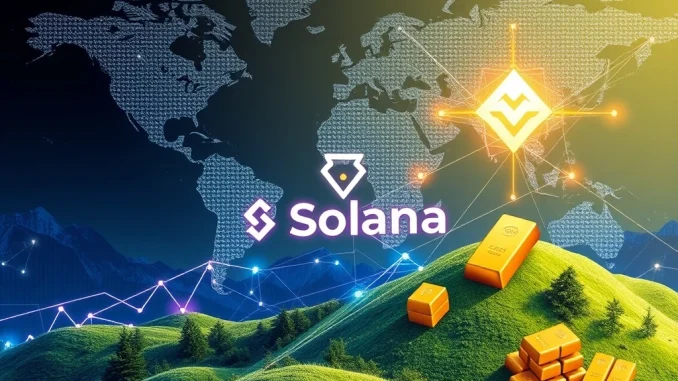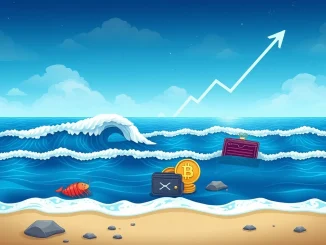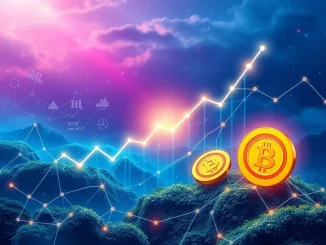
The crypto world is buzzing with activity, and Solana news today brings a truly exciting development. BioSig Technologies, a name perhaps not widely associated with blockchain until now, has just sent ripples through the market with a staggering 24.4% stock surge. What’s behind this impressive leap? It’s a strategic merger with Streamex Exchange Corporation, a pioneering force in RWA tokenization, set to redefine how we interact with real-world assets, especially commodities. This isn’t just a corporate acquisition; it’s a bold leap into the future of finance, powered by blockchain innovation.
The Transformative BioSig Stock Surge: What Does It Mean?
BioSig Technologies (NASDAQ: BSGM) recently announced the completion of its pivotal merger with Streamex, a private firm specializing in real-world asset (RWA) tokenization, particularly within the vast commodities sector. This strategic integration has already yielded dramatic results, with BioSig’s stock price skyrocketing by 24.4% following the definitive share exchange agreement. This surge isn’t merely a fleeting market reaction; it reflects a fundamental shift in BioSig’s identity and strategic direction. The combined entity is now positioned as a significant player in the U.S. market for regulated RWA tokenization. The market’s enthusiasm is palpable, with analysts forecasting a remarkable 73.3% earnings increase for BioSig in 2025, signaling a strong belief in its transition from a traditional medtech company to a blockchain-driven powerhouse. This move signals a clear intent to leverage cutting-edge technology for physical asset digitization, aligning with global trends in commodity finance.
Understanding RWA Tokenization: Why Is It a Game-Changer?
RWA tokenization is rapidly emerging as one of the most impactful applications of blockchain technology, bridging the gap between traditional finance and the digital asset world. At its core, RWA tokenization involves converting the value of tangible assets, like real estate, art, or in this case, commodities such as gold, into digital tokens on a blockchain.
Here’s why it’s considered a game-changer:
- Increased Liquidity: Traditionally illiquid assets can be traded more easily and quickly on a blockchain.
- Fractional Ownership: High-value assets can be divided into smaller, affordable units, opening investment opportunities to a broader range of investors.
- Enhanced Transparency: Blockchain’s immutable ledger provides a clear, verifiable record of ownership and transactions.
- Reduced Costs: Automation and disintermediation can lower transaction fees and administrative overhead.
- Global Accessibility: Digital assets can be accessed and traded by investors worldwide, expanding market reach significantly.
Streamex, now part of BioSig, aims to modernize commodity markets by onboarding assets like gold onto blockchain platforms, potentially expanding access for over 500 million investors globally.
The Streamex Merger: A Bold Play in Commodity Tokenization
The integration of Streamex into BioSig is not just an acquisition; it’s a strategic pivot towards capturing a significant share of the immense commodity tokenization market. Streamex Exchange Corporation brings specialized expertise in this niche, particularly with its focus on the $142 trillion global commodities market, and a specific eye on the $22 trillion gold market.
Central to Streamex’s vision is its Co-Founder and CEO, Henry McPhie, who boasts a decade of experience at the confluence of blockchain and finance. His track record includes founding Lynx Web3 Solutions and launching FatCats Capital, a successful Solana-based NFT project. McPhie’s technical acumen and entrepreneurial drive are pivotal to Streamex’s mission: to revolutionize commodity trading by offering compliant primary issuance infrastructure, decentralized exchange solutions, and secure automation for financing documentation. Their plan to denominate the combined entity’s balance sheet in gold bullion, secured through top-tier bullion banks, underscores a commitment to a value-based financial model that resonates with stability and trust.
Solana’s Strategic Role in Driving Innovation
A key aspect of this groundbreaking venture is the integration of Solana-based blockchain infrastructure. Solana is renowned for its high throughput, low transaction costs, and rapid finality, making it an ideal platform for high-volume, real-time asset tokenization. Streamex plans to leverage Solana’s robust capabilities to support recurring revenue models, ensuring secure and transparent transactions for gold-backed digital assets.
Why Solana?
- Speed: Solana can process thousands of transactions per second, crucial for active trading environments.
- Cost-Effectiveness: Its low transaction fees make micro-transactions and frequent trading economically viable.
- Scalability: Designed for enterprise-level applications, Solana can handle the anticipated growth in tokenized commodity volumes.
- Developer Ecosystem: A growing and vibrant developer community supports continuous innovation and security enhancements.
This choice positions the merged entity to build a scalable infrastructure for digital commodities, combining the inherent trust of physical gold with the efficiency and transparency of blockchain technology.
Navigating Regulation: A Path to Trust and Accessibility
One of the most critical challenges and opportunities in the RWA space is regulatory compliance. BioSig is proactively addressing this by engaging Compliance Exchange Group (CXG) to acquire a FINRA- and SEC-registered broker-dealer. This move is designed to enable the company to issue and trade tokenized assets under federal securities laws, a significant step towards legitimacy and widespread adoption.
This strategic acquisition is set to position the combined entity as one of the first publicly traded, fully regulated RWA tokenization firms in the U.S. The broker-dealer framework is expected to accelerate Streamex’s market expansion by providing both institutional and retail investors with compliant access to gold-backed digital investments. This commitment to regulatory collaboration aims to ensure a stable and secure investment environment, fostering greater trust among participants in this nascent yet rapidly expanding market.
The merger of BioSig Technologies and Streamex Exchange Corporation marks a monumental stride in the evolution of finance. By strategically combining BioSig’s public market presence with Streamex’s deep expertise in commodity tokenization and a strong foundation on Solana’s blockchain, the newly formed entity is poised to lead the charge in regulated RWA tokenization. This initiative promises to unlock unprecedented liquidity and accessibility for traditional assets, particularly gold, democratizing investment opportunities for millions. As the world watches, this venture exemplifies the transformative power of blockchain to bridge the old and new, creating a future where digital and physical assets seamlessly converge.
Frequently Asked Questions (FAQs)
Q1: What is RWA tokenization?
A1: Real-World Asset (RWA) tokenization is the process of converting tangible assets, like gold, real estate, or art, into digital tokens on a blockchain. This allows for fractional ownership, increased liquidity, and greater transparency in trading.
Q2: How does the BioSig-Streamex merger impact the RWA tokenization market?
A2: The merger positions the combined entity as a leader in the U.S. market for regulated RWA tokenization, particularly in commodities. It aims to bridge traditional finance with blockchain, offering compliant access to digital assets backed by physical commodities like gold.
Q3: Why is Solana being used for this initiative?
A3: Solana is chosen for its high speed, low transaction costs, and scalability. These features make it an ideal blockchain platform for efficiently handling the high volume of transactions and supporting recurring revenue models for tokenized gold and other commodities.
Q4: What role does regulatory compliance play in this merger?
A4: Regulatory compliance is a core focus. BioSig is acquiring a FINRA- and SEC-registered broker-dealer to ensure that tokenized assets can be issued and traded under federal securities laws. This aims to provide a regulated, secure, and trustworthy environment for investors.
Q5: What commodities are Streamex focusing on for tokenization?
A5: Streamex is primarily focusing on the vast global commodities market, with a specific emphasis on gold. They plan to denominate their balance sheet in gold bullion, secured through top-tier bullion banks, and expand access to other commodities over time.
Q6: What does the 24.4% surge in BioSig’s stock signify?
A6: The significant stock surge reflects investor confidence in BioSig’s strategic pivot from a traditional medtech company to a blockchain-driven entity focused on RWA tokenization. It signals market recognition of the potential for substantial growth and innovation in this sector.



